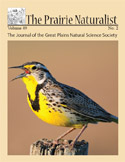Great Plains Natural Science Society

The Prairie Naturalist
Date of this Version
3-2005
Document Type
Article
Citation
THE PRAIRIE NATURALIST, Volume 37, No. 1, March 2005, pp 21-28.
Abstract
We compared the effects of two different nest placement strategies (shrubs vs. bunchgrasses) on microclimate conditions for grasshopper sparrow (Ammodramus savannarum) and lark sparrow (Chondestes grammacus) in Oklahoma. We predicted that the intensity and duration of extreme temperatures (greater than 39° C) and their variability would be reduced at shrub nests compared to bunchgrass nests. A verage maximum temperatures were similar at nests of grasshopper sparrow and lark sparrow, but confidence intervals were more variable and included biologically detrimental temperatures at grasshopper sparrow nests compared to lark sparrow nests. The proportion of time greater than 39° C also was similar at nests of both species, but on average grasshopper sparrow nests exceeded 39° C for 1.2 hr compared to 2.6 hr per 29-hr sampling period for lark sparrow nests. Our results indicate shrub nesters (lark sparrow) might be able to moderate the intensity and duration of biologically detrimental temperatures at their nests more successfully than bunch grass nesters (grasshopper sparrow).
Included in
Biodiversity Commons, Botany Commons, Ecology and Evolutionary Biology Commons, Natural Resources and Conservation Commons, Systems Biology Commons, Weed Science Commons


Comments
Published by the Great Plains Natural Science Society. Used by permission.